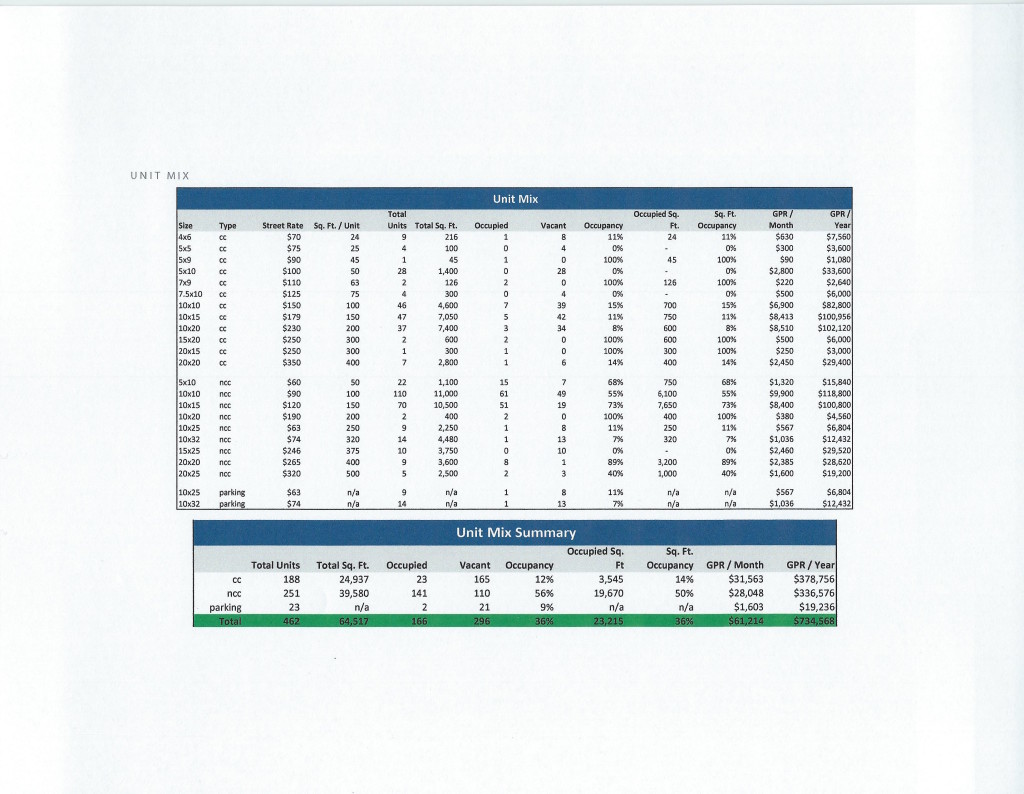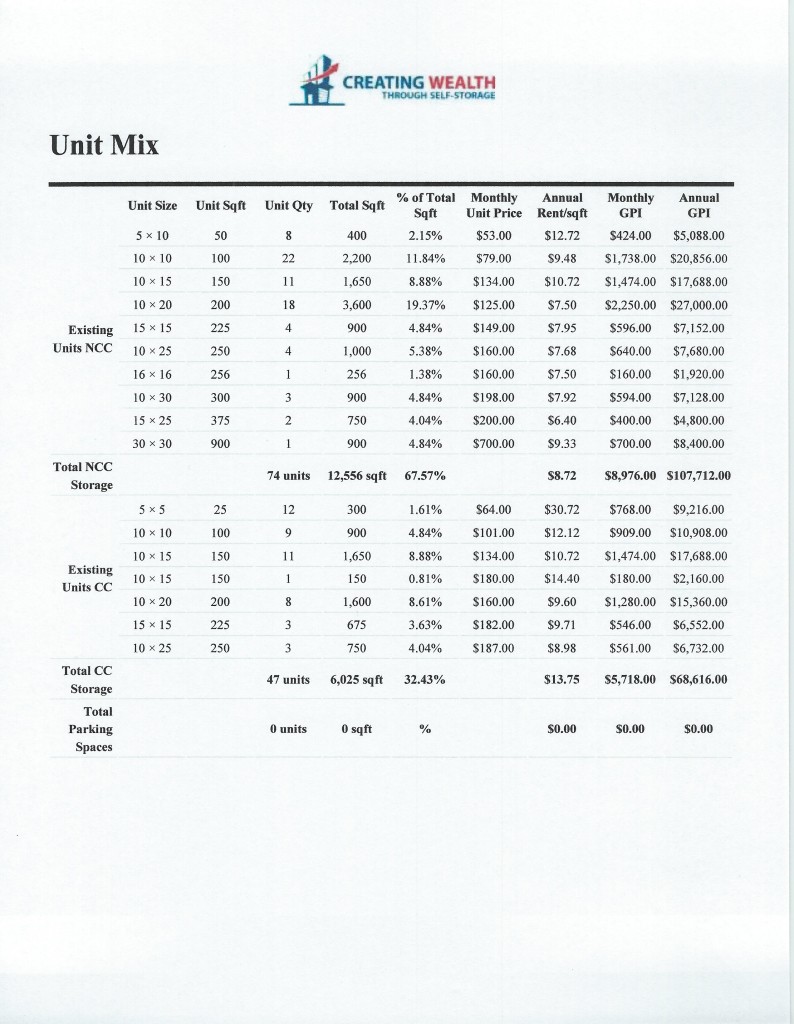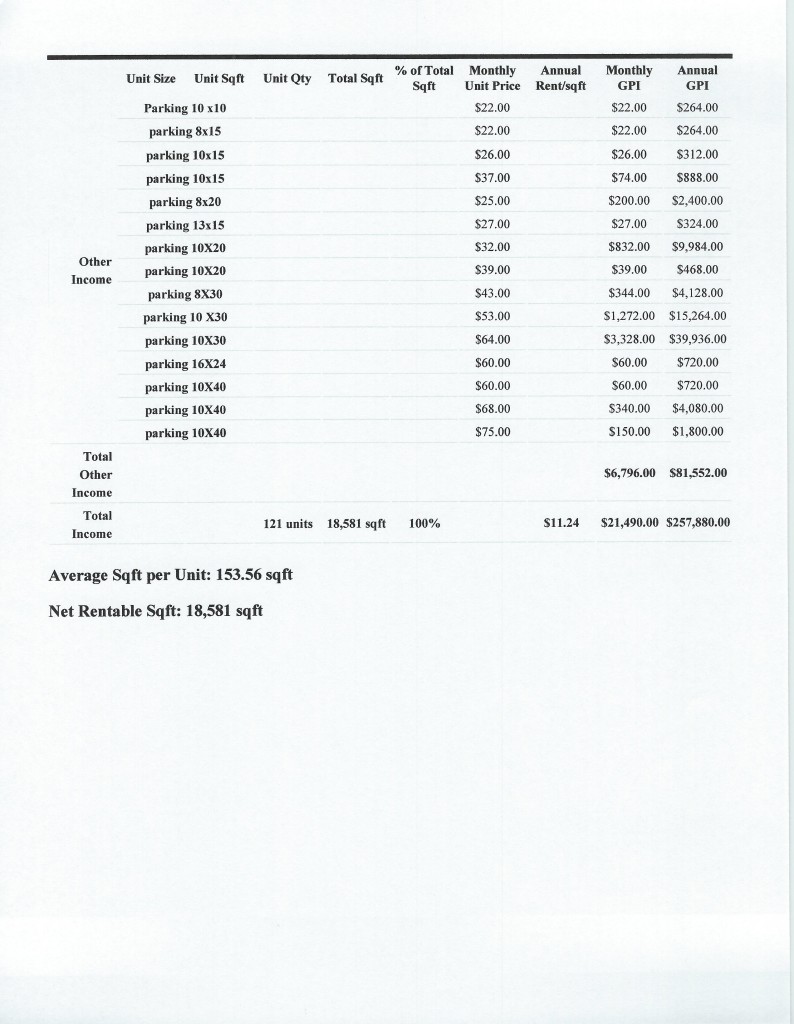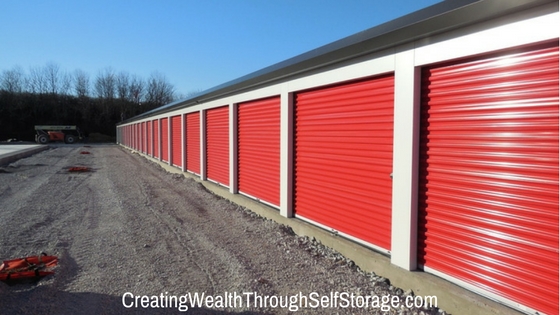It’s hard buying self storage today.
Prices are so high.
It’s not impossible to find deals in a “seller’s” market, but it does mean you have to know what you’re doing more than ever.
Welcome to the second episode of the series “How to Anaylyze Self Storage in Today’s Market.”
One strategy in today’s market is to find “value added” properties.
These include:
- existing self storage facilities that are poorly run and/or can be expanded
- vacant buildings that can be converted to a self storage facility
- raw land on which a self storage project can be constructed.
Here’s the good news: even with all the large companies in the self storage space today, over 60% of all existing facilities are owned by individuals with only one property.
Many, if not most, will be put on the market sometime in the next decade.
My experience is that most of these operators are not that sophisticated. They get very comfortable with their income stream and leave lots of money on the table. For example, when they have price increases they don’t apply them to the current customers for fear of losing them.
Many facilities could generate additional income with truck rentals as another example of lost income.
Some of the reasons I’ve heard for not investing in this income stream are:
“I don’t like truck rentals because one time customers got upset with my company when it was the truck company’s fault.”
or
“I’m in the storage business, not the truck business.”
Also, we look very closely at the difference between economic occupancy (what percentage of people are paying) compared to physical occupancy (what percentage of the facility is occupied). For more information on economic vs physical occupancy go HERE.
Often we see 10% to 20% difference between the two. It’s great when that happens because in almost every instances that is money left on the table we can get.
Our company averages between 8% and 10% in additional income just by improving the management practices on our expansion acquisitions. This is before we put the first new unit in service. This is not the series to go into management practices, but if you are interested, watch or read the management series beginning HERE or you can see all my past blog posts on management HERE.
The first step to buying or building self storage in a seller’s market is being able to correctly analyze a self storage facility.
In the last post, I asked you to come to this episode with a project to analyze. Let’s start!
There are four main types of self storage opportunities you could have brought. I will cover each separately in this episode.
- Existing self storage facility. (“Existing”)
- An expansion (existing facility with additional land to expand on). (“Expansion”)
- A conversion (a building to be converted into self storage). (“Conversion”)
- Land to build a self storage facility on. (“New Construction”)
(If you didn’t, stop here, go get a project you want to analyze. This will be a very different experience if you are doing the work as opposed to reading about it. Let’s get out of the stands and onto the field.)
One of the main differences between self storage and any other type of income producing commercial real estate is how we generate the income. In all other types of real estate, a rent roll is used to generate income. In self storage, we use a unit mix and/or a square footage income figure.
The reason I ended up creating the Storage World Analyzer was I couldn’t find a financial analysis program that worked well for self storage. But you can also use Excel or something if you are good with spreadsheets.
In these examples, I am going to use both Excel and the Storage World Analyzer. I like the Analyzer because it is easier to use and see the results. It’s also my hope you may want to use it too (but don’t feel you have to have it to be successful).
Existing:
The first thing you do is enter the unit mix from the Seller’s package. I know it is hard to get sometimes, but you can’t proceed any further with out it. Also, make sure you do the calculations yourself in your own analysis tool and don’t rely on what you get from the agent or Seller. I often find errors in their packages.
So here is a picture of a unit mix page on a project I am looking at.

This is often what a unit mix page may look like in a “For Sale” package created by a commercial real estate agent. It shows unit sizes, how many, and asking prices.
Here is what a unit mix page may look like after the data is entered.


Now you have created the “Gross Potential Income” (GPI). This is the maximum amount of rent that could possibly be collected. If every unit was paying the full price, this is the maximum rent possible.
But that never happens. You need to determine the “Stabilized Occupancy.” What is the amount of occupancy and rent payment one can realistically expect?
A Feasibility Report will ultimately tell you, but for now, I usually use 85% or 88%. If you happen to be looking at a property that is currently lower than that, use a lower figure in the first years or so. If it is a normal self storage property it should level off somewhere between 85% and 88% of GPI.
Expansion:
We love these right now, and I recommend you start liking them too. They start generating income from Day One while you create your value-add for the increased income. Although on Day One we may not be receiving the return we want, in most cases there is enough income to cover our expenses while we expand the project.
Look for properties with
- additional land
- adjoining land you could purchase
- properties with lots of parking which could be converted to self storage.
Now for determining the income potential for expansion opportunities, do the following:Follow the steps in the “Existing” model to determine the current and potential income. Remember that if you are using parking land for the expansion, remove any parking income from the GPI.
1 Follow the steps in the “Existing” model to determine the current and potential income. Remember that if you are using parking land for the expansion, remove any parking income from the GPI.
2. Figure out, or guess, how much expansion land there is in square feet.
Benchmark Number: 1 Acre has 43, 560 square feet
3. We use 33% efficiency against land size to determine how many “Net Rentable Square Feet of Self Storage” we can build on a piece of land.
Example: 1 acre of land.
43,560 x .33 = 14,375 net square feet of income-producing square footage (some land configurations can have more or less per acre, this is just for estimating purposes)
4. Determine the percentage of climate controlled you want and non-climate controlled units you want.
Benchmark Number: on average, facilities that have a mix run about 35% climate controlled. However, do not be afraid to have more or less.
5. Use the per square foot income number in the “Existing” unit mix to apply to the climate-controlled square footage and non-climate controlled square feet to determine Gross Potential Income for the expansion self storage. In the Unit Mix Page in the Existing example, the non-climate controlled space was $8.72 per square foot per year, and $13.75 per square foot per year for climate controlled space.
Conversion:
We also like conversions today. Usually these are 100% or very close to 100% climate controlled units (because most are inside a building). Again, your feasibility report will tell you if the market will absorb this product you are considering creating.
We like conversions because they start generating income faster than new construction in most cases. However, you usually start with zero income, and break even can be between 55% and 65% occupancy.
Here is a fast way to determine the income for analysis purposes on conversions.
1 Determine the building height. You need a minimum of 8 to 9 feet per floor, depending on the storage system you are erecting. Determine if you can get two floors or more in the building. If at all possible, try to find buildings with a minimum of 16 feet to 18 feet height to the bottom of the supporting roof beam.
2. After you have determined how many floors of self storage you can get, determine the size of each “floor plate” (i.e. the gross interior buildable area in square feet per floor).
Example: A building floor plate that is 200 feet by 400 feet is 80,000 square feet (200 x 400 = 80,000)
3. We use 75% efficiency to determine how many income producing square feet of self storage we can get per floor plate.
Example: 2 floor plates 200 by 400:
200 x 400 = 80,000
80,000 x .75 = 60,000
60,000 x 2 = 120,000 square feet of income producing self storage4. Next, estimate the per square foot income you can expect to generate. This is done by getting the rental rates from nearby facilities and converting them to per square foot income numbers. Again, ultimately your feasibility report will tell you what you can expect, but this is what we do in the early stages of analysis.
4. Next, estimate the per square foot income you can expect to generate. This is done by getting the rental rates from nearby facilities and converting them to per square foot income numbers. Again, ultimately your feasibility report will tell you what you can expect, but this is what we do in the early stages of analysis.
Example: I obtained these numbers from nearby facilities by calling and going to websites, then averaged them to get:
5 x 5 25 sq. ft. $35 monthly
10 x 10 100 sq. ft. $85 monthly
10 x 15 150 sq. ft. $110 monthly
10 x 20 200 sq. ft. $130 monthly
475 sq. ft. = $360
$360 divided by 475 = $.76 psf monthly or $9.09 psf yearly
$9.09 x 120,000 = $1,091,368 GPI
So in this fictitious example of a building with two floors that are 80,000 square feet and these nearby facilities with the above average pricing, we can conclude that the GPI is $1,091,368.
Next week we will learn how the calculate the lease up of that income.
New Construction
New construction is a valid option today, especially if you have some construction experience. However, it is not for the faint of heart. You can go two to three years with negative cash flow but the returns can be very high.
We use a combination of all of the above to grow our portfolio. We believe a balanced acquisition approach spreads out our risk and maximizes the overall return we can get.
We will discuss more about construction and construction budgets required for Expansions, Conversions, and New Construction next week. In the course How To Build Your First Self Storage Facility at the Quick Start Academy, (also great for expansions and conversions), we go into detail about this and have budget templates. There is also lots of other support out there at the ISS and the SSA to support you for this part of your learning curve.
For now, let’s discuss how to project the income on a new construction project. I am not going into what makes a good site, where it should be, etc. I’m assuming you have a site you want to go forward on and already have, or are in the process of getting a Feasibility Report.
1 Figure out how much development land there is in square feet.
Benchmark Number: 1 Acre has 43, 560 square feet
We use 33% efficiency against land size to determine how many “Net Rentable Square Feet of Self Storage” we can build on a piece of land.
Example: 3.5 acres of land.
43,560 x 3.5 = 152,460 square feet of land
152,460 x .33 = 50,312 net square feet of income-producing self storage on the 3.5 acres (some land configurations can have more or less, this is just for estimating purposes)
2. Determine the percentage of climate controlled you want and non-climate controlled units you want.
Benchmark Number: On average for facilities with both climate controlled and non-climate controlled units, about 35% climate controlled is average. However, do not be afraid to have more or less.
3. Next, estimate the per square foot income you can expect to generate. This is done by getting the rental rates from nearby facilities and converting them to per square foot income numbers. Again, ultimately your feasibility report will tell you what you can expect, but this is what we do in the early stages of analysis. Refer to number 4 in Conversions above for an example. Be sure to do this for both climate controlled space and non climate controlled space.
4. Apply the stabilized occupancy rate as discussed in Existing above.
Now, this may seem like a lot of work, but really, it is quite simple. This is not an exact science, especially in the initial stages. Just run your numbers and see if the project begins to make sense given your self storage business strategy.
We will go further into it next week, but make sure you understand the process for determining the Gross Potential Income for the different types of self storage opportunities, and how to get the expected income for the project with stabilized occupancy.
You now know more than most people in the self storage business itself. Generating income for self storage is a very different process from any other type of commercial income-producing asset. Now you know or have the data necessary to know, how to project income for four different types of opportunities that may present themselves as you look at starting or growing your self storage business in today’s market.
For whatever opportunity you brought to this episode, generate the GPI and the Net Income Potential after stabilized occupancy.
In the next episode, we will take the next step in learning how to analyze self storage like a pro.




WOW, how simple you make it and easy to understand…that’s a gift. Thank you
Highlights are:
1). bench-marks
2). systematic approach to analyzing and how each of the property types complement the others by giving a holistic approach to know the material in my sleep.
3). the format of verbal, written, and giving easy to follow examples.